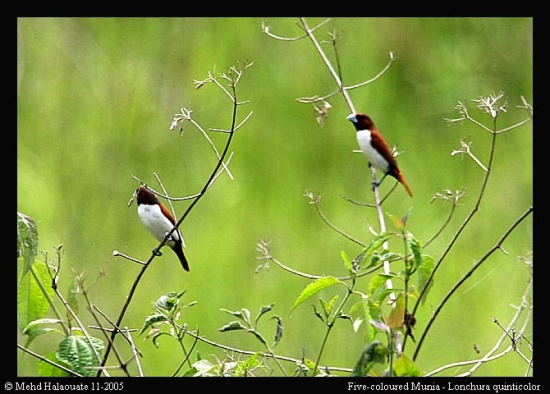- Lonchura quinticolor
Identification
11·5 cm. 4.5 inches
Adult
- Head is dark reddish brown,
- Crown and nape duller than head, with grey tips to feathers
- Ear coverts have fine pale streaked shafts
- Iris dark brown
- Thin dark grey eye ring
- Beak pale grey
- Chin and throat brownish black,
- Upperparts reddish brown
- Rump, uppertail coverts white
- Belly white
- Black lower belly and undertail coverts
- Outer retrices yellow to maroon
- Legs grey.
- Sexes similar.
Juvenile
- Ear coverts with thin pale streaks on shaft
- Brown upperparts
- Light brown underparts breast brightest
- Juvenile to adult moult complete at 3–4 months.
Chick
- Almost naked
- Skin pale pink
- Gape blue initially, turning white by day 10
- Edge of Beak with black border lined with two black vertical bars
- Palate yellow with two long, thin black lines, rear bar incomplete in mid line
- Tongue with spots on edge
- Black sublingual bar
Distribution
Lesser Sundas and south western Moluccan islands, Indonesia
Taxonomy
This is a monotypic species[1].
Three subspecies wallacii, sumbae and quinticolor are recognised by some authorities[2]
Habitat
Up to 1600 m.
Grassland, cultivation including paddy fields, forest clearings, sparsely wooded savannah and mixed scrub.
Behaviour
Diet
Wild grass seeds and rice. Feeds on ground and by climbing up stem to reach seed heads. Forages in pairs and small groups, sometimes in large flocks; Mixes with other species of the same genus.
Breeding
February to May and August on Flores. Male stands vertical during displays, with puffed out head and belly feathers, and sings softly.
Nest acompact ball of grass in tall grass. 5–6 eggs; incubated by both sexes during day and by the female at night, incubation lasts 14–16 days. Fledges in 21 days. Fledglings called to roost.
Vocalisation
Male call a loud double "triprip".
Female call is a single "peet".
Song a soft "te te te" changing to two "weeee" and finishing with a soft "pti-ti-pti-pti".
References
- Clements, J. F., T. S. Schulenberg, M. J. Iliff, D. Roberson, T. A. Fredericks, B. L. Sullivan, and C. L. Wood. 2014. The eBird/Clements checklist of birds of the world: Version 6.9., with updates to August 2014. Downloaded from http://www.birds.cornell.edu/clementschecklist/download/
- Avibase
- Handbook of the Birds of the World Alive (retrieved August 2015)
Recommended Citation
- BirdForum Opus contributors. (2024) Five-coloured Munia. In: BirdForum, the forum for wild birds and birding. Retrieved 27 April 2024 from https://www.birdforum.net/opus/Five-coloured_Munia




